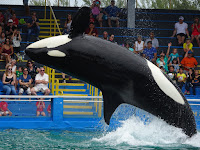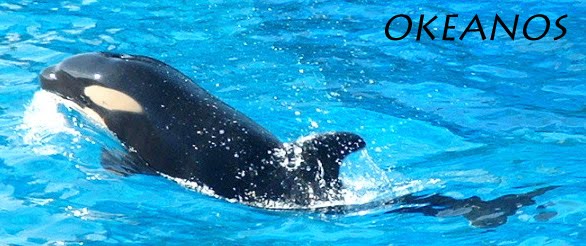So I’ve
decided to once again reflect on my view on the keeping of orcas in captivity.
And once again, I don’t feel overly black and white on the matter. I don’t feel
that I have a strong opinion either way. Over half my life I have been following
the captive orca industry, and I feel a connection to these individuals that I
have come to know. When I watched Blackfish for the first time back in 2013, I
sat there feeling very uncomfortable, because everything they highlighted I
already knew about, and I still hadn’t been swayed to an anti-captivity opinion
(which obviously the movie wanted to make you feel). As the public opposition
to the captive industry grew, I’ve almost felt as if I have had to hide the
fact that I still want to see captive orcas. I’ve been labelled a hypocrite for
studying animal welfare yet not being anti-captivity. It is actually an
ambition of mine to do a world tour of every park around the world that has
orcas, and I want to do this to honour my 11 year old self who gained this
unique interest. I hope to do this over a few months in perhaps 2023, once I
have saved enough money.
 But my point
is, just because I want to see orcas in captivity, does not mean I am
pro-captivity. The welfare issues that orcas suffer from mean that captive
enclosures are not suitable for them. I disagree with the artificial social
groupings, and inability for the orcas to escape each other, which can lead to
heightened aggression. I’ve seen the rake marks on orcas, even on 4 day old
Athena (back in 2004), which may not be so prevalent in wild populations. Fortunately
the Western parks seem to have stopped transferring their orcas around (the
last orca being transferred between parks was Shouka in August 2012 to SeaWorld
San Diego)[1], and separating mothers and calves, which may have been a result
of The Blackfish Effect. It’s also very depressing when visiting the parks and
to see many of them floating at the surface so lifelessly (which I remember
very well Keet being like this). It’s as if they are completely disengaged from
each other and their surroundings. I’m very pleased that SeaWorld announced this
would be their last generations of orcas in 2016 [2], and it seems to be the
case for the other Western parks too (except for Loro Parque who gained baby
Ula in September 2018).
But my point
is, just because I want to see orcas in captivity, does not mean I am
pro-captivity. The welfare issues that orcas suffer from mean that captive
enclosures are not suitable for them. I disagree with the artificial social
groupings, and inability for the orcas to escape each other, which can lead to
heightened aggression. I’ve seen the rake marks on orcas, even on 4 day old
Athena (back in 2004), which may not be so prevalent in wild populations. Fortunately
the Western parks seem to have stopped transferring their orcas around (the
last orca being transferred between parks was Shouka in August 2012 to SeaWorld
San Diego)[1], and separating mothers and calves, which may have been a result
of The Blackfish Effect. It’s also very depressing when visiting the parks and
to see many of them floating at the surface so lifelessly (which I remember
very well Keet being like this). It’s as if they are completely disengaged from
each other and their surroundings. I’m very pleased that SeaWorld announced this
would be their last generations of orcas in 2016 [2], and it seems to be the
case for the other Western parks too (except for Loro Parque who gained baby
Ula in September 2018).
 Therefore, I
think the most realistic option is to just let this remaining generation of
orcas live out the rest of their lives in captivity. And whilst they must
remain in captivity, they will be under the care of trainers who genuinely do
love the orcas and want what’s best for them. Trainers are not bad people at
all. I’m still indecisive on whether orcas should perform or not. As said
above, I have seen orcas be very inactive in-between shows, therefore I don’t
think that shows are entirely bad, as they do offer a change of pace for the
orcas. However some of the unnatural tricks could definitely be phased out,
such as making orcas “break-spin” on the slide outs.
Therefore, I
think the most realistic option is to just let this remaining generation of
orcas live out the rest of their lives in captivity. And whilst they must
remain in captivity, they will be under the care of trainers who genuinely do
love the orcas and want what’s best for them. Trainers are not bad people at
all. I’m still indecisive on whether orcas should perform or not. As said
above, I have seen orcas be very inactive in-between shows, therefore I don’t
think that shows are entirely bad, as they do offer a change of pace for the
orcas. However some of the unnatural tricks could definitely be phased out,
such as making orcas “break-spin” on the slide outs.
 But my point
is, just because I want to see orcas in captivity, does not mean I am
pro-captivity. The welfare issues that orcas suffer from mean that captive
enclosures are not suitable for them. I disagree with the artificial social
groupings, and inability for the orcas to escape each other, which can lead to
heightened aggression. I’ve seen the rake marks on orcas, even on 4 day old
Athena (back in 2004), which may not be so prevalent in wild populations. Fortunately
the Western parks seem to have stopped transferring their orcas around (the
last orca being transferred between parks was Shouka in August 2012 to SeaWorld
San Diego)[1], and separating mothers and calves, which may have been a result
of The Blackfish Effect. It’s also very depressing when visiting the parks and
to see many of them floating at the surface so lifelessly (which I remember
very well Keet being like this). It’s as if they are completely disengaged from
each other and their surroundings. I’m very pleased that SeaWorld announced this
would be their last generations of orcas in 2016 [2], and it seems to be the
case for the other Western parks too (except for Loro Parque who gained baby
Ula in September 2018).
But my point
is, just because I want to see orcas in captivity, does not mean I am
pro-captivity. The welfare issues that orcas suffer from mean that captive
enclosures are not suitable for them. I disagree with the artificial social
groupings, and inability for the orcas to escape each other, which can lead to
heightened aggression. I’ve seen the rake marks on orcas, even on 4 day old
Athena (back in 2004), which may not be so prevalent in wild populations. Fortunately
the Western parks seem to have stopped transferring their orcas around (the
last orca being transferred between parks was Shouka in August 2012 to SeaWorld
San Diego)[1], and separating mothers and calves, which may have been a result
of The Blackfish Effect. It’s also very depressing when visiting the parks and
to see many of them floating at the surface so lifelessly (which I remember
very well Keet being like this). It’s as if they are completely disengaged from
each other and their surroundings. I’m very pleased that SeaWorld announced this
would be their last generations of orcas in 2016 [2], and it seems to be the
case for the other Western parks too (except for Loro Parque who gained baby
Ula in September 2018).
However, I
am not entirely sold on the sea pen proposal anymore. After doing some reading,
I actually found it very interesting that sea pens may not be the best option
after all. Ocean noise is actually a serious problem for wild cetaceans (and has
caused many cetaceans to strand and die)[3], and therefore being in a sea pen
they may be exposed to such uncontrollable noises. There is also the risk of
people cutting the sea pens and releasing the orcas into the wild (many of
which, the captive-born ones, probably won’t be able to survive for too long).
It is also possible that plastic and other debris may get inside the sea pen.
The maintenance of sea pens is actually seemingly very complex, with different
challenges to captive enclosures. The financial cost of transferring every
captive orca into a sea pen would also be incredibly high. The cost to
rehabilitate Keiko in Iceland, was supposedly $20 million [34]. Granted, this
was a rehabilitation effort, whereas the aim of the relocating captive orcas
into sea pens isn’t to release them, this does still show that it would be far
from inexpensive. Cost aside, I also don’t even think the parks will surrender their
orcas to this project – activists have been campaigning for Lolita to be moved
from the Miami Seaquarium for decades, and have yet to have any success,
therefore I can’t see the parks will give up their orcas for this cause.
 Therefore, I
think the most realistic option is to just let this remaining generation of
orcas live out the rest of their lives in captivity. And whilst they must
remain in captivity, they will be under the care of trainers who genuinely do
love the orcas and want what’s best for them. Trainers are not bad people at
all. I’m still indecisive on whether orcas should perform or not. As said
above, I have seen orcas be very inactive in-between shows, therefore I don’t
think that shows are entirely bad, as they do offer a change of pace for the
orcas. However some of the unnatural tricks could definitely be phased out,
such as making orcas “break-spin” on the slide outs.
Therefore, I
think the most realistic option is to just let this remaining generation of
orcas live out the rest of their lives in captivity. And whilst they must
remain in captivity, they will be under the care of trainers who genuinely do
love the orcas and want what’s best for them. Trainers are not bad people at
all. I’m still indecisive on whether orcas should perform or not. As said
above, I have seen orcas be very inactive in-between shows, therefore I don’t
think that shows are entirely bad, as they do offer a change of pace for the
orcas. However some of the unnatural tricks could definitely be phased out,
such as making orcas “break-spin” on the slide outs.
As I’ve said
in my 2015 post, I am very concerned about the growing orca industry in the
East. I do not support orcas being taken from the wild. I am also concerned
about the welfare issues that the orcas may face in these countries (as I have
seen first-hand poor welfare conditions for bears in China). This is going to
be a difficult matter to tackle. Fortunately there was mass public outcry at
the captures of the orcas and belugas being held in the “Whale Jail” in Russia
in 2018/2019, which led to their release [5]. Therefore, hopefully it is less
likely that any further wild captures will go ahead, as the world is now
watching. But as the captive orca industry in the East is in its early stages,
it may take a while for them to reach the point that we are at now in the West.
I’m sure
within my lifetime I will see the end of the captive orca industry in its
entirety, which is the best outcome for the orcas welfare. However, whilst I
still have the chance, I do want to take advantage of the possibility of seeing
the captive orcas I have come to know, before it becomes a thing of the past…
References


No comments:
Post a Comment